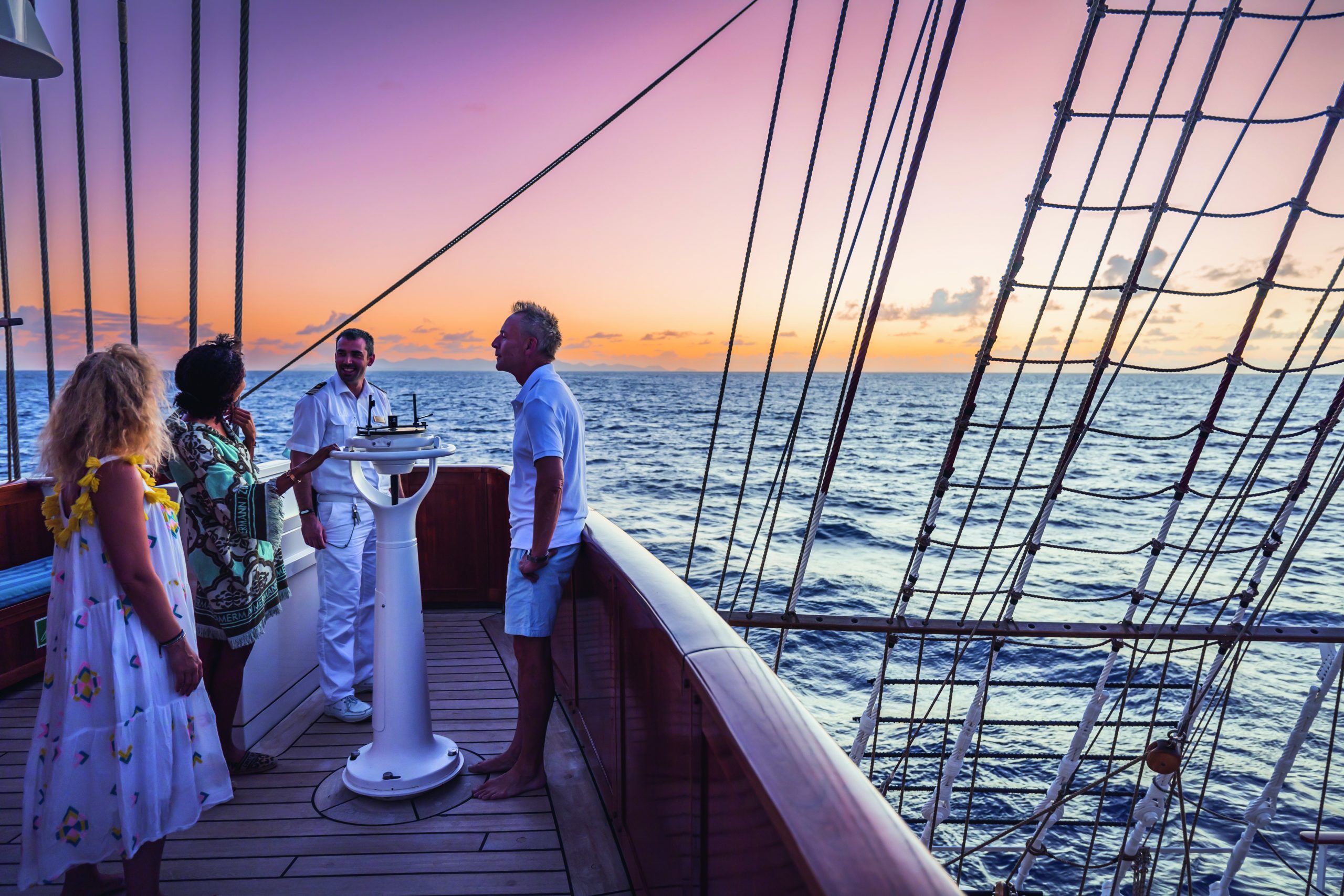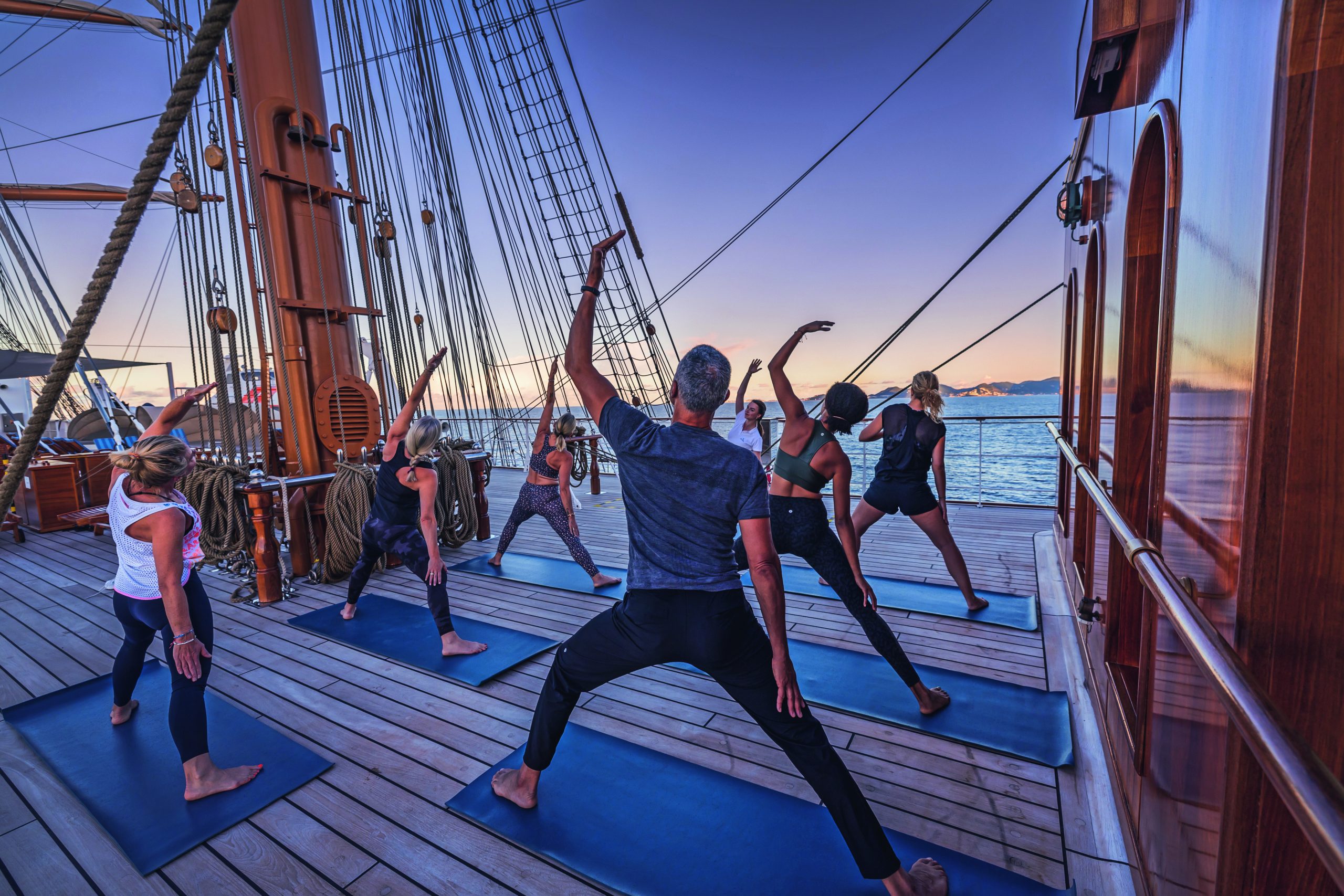Itinerary
Venice is a city unlike any other. No matter how often you’ve seen it in photos and films, the real thing is more dreamlike than you could imagine. With canals where streets should be, water shimmers everywhere. The fabulous palaces and churches reflect centuries of history in what was a wealthy trading center between Europe and the Orient. Getting lost in the narrow alleyways is a quintessential part of exploring Venice, but at some point you’ll almost surely end up in Piazza San Marco, where tourists and locals congregate for a coffee or an aperitif.
One of the true jewels of the Mediterranean, Rovinj is a jaw-droppingly beautiful town, which juts out into sparkling Mediterranean. Dominated by the pencil-like bell tower of the Venetian Saint Euphemia Cathedral, pine tree forests flow to the borders of the quaint Old Town – which evokes the romantic, tangled backstreets of the Venice. Rovinj – or Rovino in Italian – is a city of split personalities, with two official languages – having been owned by the Kingdom of Italy between 1919 and 1947.
Dalmatia’s capital for more than 1,000 years, Zadar is all too often passed over by travelers on their way to Split or Dubrovnik. What they miss out on is a city of more than 73,000 that is remarkably lovely and lively despite—and, in some measure, because of—its tumultuous history. The Old Town, separated from the rest of the city on a peninsula some 4 km (2½ miles) long and just 1,640 feet wide, is bustling and beautiful: the marble pedestrian streets are replete with Roman ruins, medieval churches, palaces, museums, archives, and libraries. Parts of the new town are comparatively dreary, a testament to what a world war followed by decades of communism, not to mention a civil war, can do to the architecture of a city that is 3,000 years old. A settlement had already existed on the site of the present-day city for some 2,000 years when Rome finally conquered Zadar in the 1st century BC; the foundations of the forum can be seen today. Before the Romans came the Liburnians had made it a key center for trade with the Greeks and Romans for 800 years. In the 3rd century BC the Romans began to seriously pester the Liburnians, but required two centuries to bring the area under their control. During the Byzantine era, Zadar became the capital of Dalmatia, and this period saw the construction of its most famous church, the 9th-century St. Donat’s Basilica. It remained the region’s foremost city through the ensuing centuries. The city then experienced successive onslaughts and occupations—both long and short—by the Osogoths, the Croatian-Hungarian kings, the Venetians, the Turks, the Habsburgs, the French, the Habsburgs again, and finally the Italians before becoming part of Yugoslavia and, in 1991, the independent republic of Croatia. Zadar was for centuries an Italian-speaking city, and Italian is still spoken widely, especially by older people. Indeed, it was ceded to Italy in 1921 under the Treaty of Rapallo (and reverted to its Italian name of Zara). Its occupation by the Germans from 1943 led to intense bombing by the Allies during World War II, which left most of the city in ruins. Zadar became part of Tito’s Yugoslavia in 1947, prompting many Italian residents to leave. Zadar’s most recent ravages occurred during a three-month siege by Serb forces and months more of bombardment during the Croatian-Serbian war between 1991 and 1995. But you’d be hard-pressed to find outward signs of this today in what is a city to behold. There are helpful interpretive signs in English all around the Old Town, so you certainly won’t feel lost when trying to make sense of the wide variety of architectural sites you might otherwise pass by with only a cursory look.
Split’s ancient core is so spectacular and unusual that a visit is more than worth your time. The heart of the city lies within the walls of Roman emperor Diocletian’s retirement palace, which was built in the 3rd century AD. Diocletian, born in the nearby Roman settlement of Salona in AD 245, achieved a brilliant career as a soldier and became emperor at the age of 40. In 295 he ordered this vast palace to be built in his native Dalmatia, and when it was completed he stepped down from the throne and retired to his beloved homeland. Upon his death, he was laid to rest in an octagonal mausoleum, around which Split’s magnificent cathedral was built.In 615, when Salona was sacked by barbarian tribes, those fortunate enough to escape found refuge within the stout palace walls and divided up the vast imperial apartments into more modest living quarters. Thus, the palace developed into an urban center, and by the 11th century the settlement had expanded beyond the ancient walls.Under the rule of Venice (1420–1797), Split—as a gateway to the Balkan interior—became one of the Adriatic’s main trading ports, and the city’s splendid Renaissance palaces bear witness to the affluence of those times. When the Habsburgs took control during the 19th century, an overland connection to Central Europe was established by the construction of the Split–Zagreb–Vienna railway line.After World War II, the Tito years saw a period of rapid urban expansion: industrialization accelerated and the suburbs extended to accommodate high-rise apartment blocks. Today the historic center of Split is included on UNESCO’s list of World Heritage Sites.
Off the coast of Croatia in the southern Adriatic Sea lie some thousand islands and the largest of them, Korçula, is considered the most beautiful. With an average of 3,000 hours of sunshine per annum, which guarantees a wide assortment of Mediterranean vegetation, it is not difficult to understand why seasoned travelers compare Korçula to a latter-day Eden. Separated from the mainland by a channel of only one mile, Korçula’s main town, named the same as the island, ranks among the best preserved medieval towns in the Mediterranean. It is the island’s main tourist, economic and cultural center. Thanks to its strategic location along the sea trade routes, Korçula has always attracted travelers and settlers. Korcula was founded by Greek colonists, who were followed by Illyrians, Romans and finally the Croats. The Korçula Statute of 1214 is one of the oldest legal documents to have been adopted in this part of Europe. The same century saw the birth of the famous world traveler, Marco Polo. The house said to be his birthplace can be seen in town. Korçulans have always been known as keen seafarers, excellent shipbuilders, stonemasons and artists. From their many voyages, sailors brought back new ideas, which eventually mixed with local customs. To this day, Korçula has maintained the tradition of performing knightly games such as the chivalrous Moreska dance, which has been in existence for more than 400 years. Visitors to Korçula enjoy its stunning location, natural beauty and medieval ambiance. And if that’s not enough, the town offers numerous attractions that are within walking distance from the pier, including the City Museum and the Bishop’s Treasury.
Nothing can prepare you for your first sight of Dubrovnik. Lying 216 km (135 miles) southeast of Split and commanding a jaw-dropping coastal location, it is one of the world’s most beautiful fortified cities. Its massive stone ramparts and fortress towers curve around a tiny harbor, enclosing graduated ridges of sun-bleached orange-tiled roofs, copper domes, and elegant bell towers. Your imagination will run wild picturing what it looked like seven centuries ago when the walls were built, without any suburbs or highways around it, just this magnificent stone city rising out of the sea.In the 7th century AD, residents of the Roman city Epidaurum (now Cavtat) fled the Avars and Slavs of the north and founded a new settlement on a small rocky island, which they named Laus, and later Ragusa. On the mainland hillside opposite the island, the Slav settlement called Dubrovnik grew up. In the 12th century the narrow channel separating the two settlements was filled in (now the main street through the Old Town, called Stradun), and Ragusa and Dubrovnik became one. The city was surrounded by defensive walls during the 13th century, and these were reinforced with towers and bastions in the late 15th century.From 1358 to 1808 the city thrived as a powerful and remarkably sophisticated independent republic, reaching its golden age during the 16th century. In 1667 many of its splendid Gothic and Renaissance buildings were destroyed by an earthquake. The defensive walls survived the disaster, and the city was rebuilt in baroque style.Dubrovnik lost its independence to Napoléon in 1808, and in 1815 passed to Austria-Hungary. During the 20th century, as part of Yugoslavia, the city became a popular tourist destination, and in 1979 it was listed as a UNESCO World Heritage Site. During the war for independence, it came under heavy siege. Thanks to careful restoration, few traces of damage remain; however, there are maps inside the Pile and Ploče Gates illustrating the points around the city where damage was done. It’s only when you experience Dubrovnik yourself that you can understand what a treasure the world nearly lost
Located right in the heel of the Italian boot, Otranto’s scenic landscape often plays the protagonist in displaying the beauty of Puglia, Italy’s easternmost region. Facing the Adriatic sea, the seducing weather and pristine waters have made it a popular destination where on a clear day, wanderers can see the coast of Albania. Like much of Italy, the city boasts a rich and mixed history. Once a Greek and Roman port, it was later occupied by the Byzantines, the Normans and the Spanish before the Ottoman invaded in during their Jihad to conquer Europe. Remains of forts are still visible and are a living testimonial of the town’s rich history along with Otranto’s cathedral, which still encloses today the relics of martyrs who refused to convert to Islam.
Siracusa, known to English speakers as Syracuse, is a wonder to behold. One of the great ancient capitals of Western civilization, the city was founded in 734 BC by Greek colonists from Corinth and soon grew to rival, and even surpass, Athens in splendor and power. It became the largest, wealthiest city-state in the West and a bulwark of Greek civilization. Although Siracusa lived under tyranny, rulers such as Dionysius filled their courts with Greeks of the highest cultural stature—among them the playwrights Aeschylus and Euripides, and the philosopher Plato. The Athenians, who didn’t welcome Siracusa’s rise, set out to conquer Sicily, but the natives outsmarted them in what was one of the greatest military campaigns in ancient history (413 BC). The city continued to prosper until it was conquered two centuries later by the Romans.Present-day Siracusa still has some of the finest examples of Baroque art and architecture; dramatic Greek and Roman ruins; and a Duomo that’s the stuff of legend—a microcosm of the city’s entire history in one building. The modern city also has a wonderful, lively, Baroque old town worthy of extensive exploration, as well as pleasant piazzas, outdoor cafés and bars, and a wide assortment of excellent seafood. There are essentially two areas to explore in Siracusa: the Parco Archeologico (Archaeological Zone), on the mainland; and the island of Ortygia, the ancient city first inhabited by the Greeks, which juts out into the Ionian Sea and is connected to the mainland by two small bridges. Ortygia is becoming increasingly popular with tourists, and is starting to lose its old-fashioned charm in favor of modern boutiques.Siracusa’s old nucleus of Ortygia, a compact area, is a pleasure to amble around without getting unduly tired. In contrast, mainland Siracusa is a grid of wider avenues. At the northern end of Corso Gelone, above Viale Paolo Orsi, the orderly grid gives way to the ancient quarter of Neapolis, where the sprawling Parco Archeologico is accessible from Viale Teracati (an extension of Corso Gelone). East of Viale Teracati, about a 10-minute walk from the Parco Archeologico, the district of Tyche holds the archaeological museum and the church and catacombs of San Giovanni, both off Viale Teocrito (drive or take a taxi or city bus from Ortygia). Coming from the train station, it’s a 15-minute trudge to Ortygia along Via Francesco Crispi and Corso Umberto. If you’re not up for that, take one of the free electric buses leaving every 10 minutes from the bus station around the corner.
Malta’s capital, the minicity of Valletta, has ornate palaces and museums protected by massive fortifications of honey-color limestone. Houses along the narrow streets have overhanging wooden balconies for people-watching from indoors. Generations ago they gave housebound women a window on the world of the street. The main entrance to town is through the City Gate (where all bus routes end), which leads onto Triq Repubblika (Republic Street), the spine of the grid-pattern city and the main shopping street. Triq Mercante (Merchant Street) parallels Repubblika to the east and is also good for strolling. From these two streets, cross streets descend toward the water; some are stepped. Valletta’s compactness makes it ideal to explore on foot. City Gate and the upper part of Valletta are experiencing vast redevelopment that includes a new Parliament Building and open-air performance venue. The complex, completed mid-2013, has numerous pedestrian detours in place along with building noise and dust. Before setting out along Republic Street, stop at the tourist information office on Merchant Street for maps and brochures.
Ship features
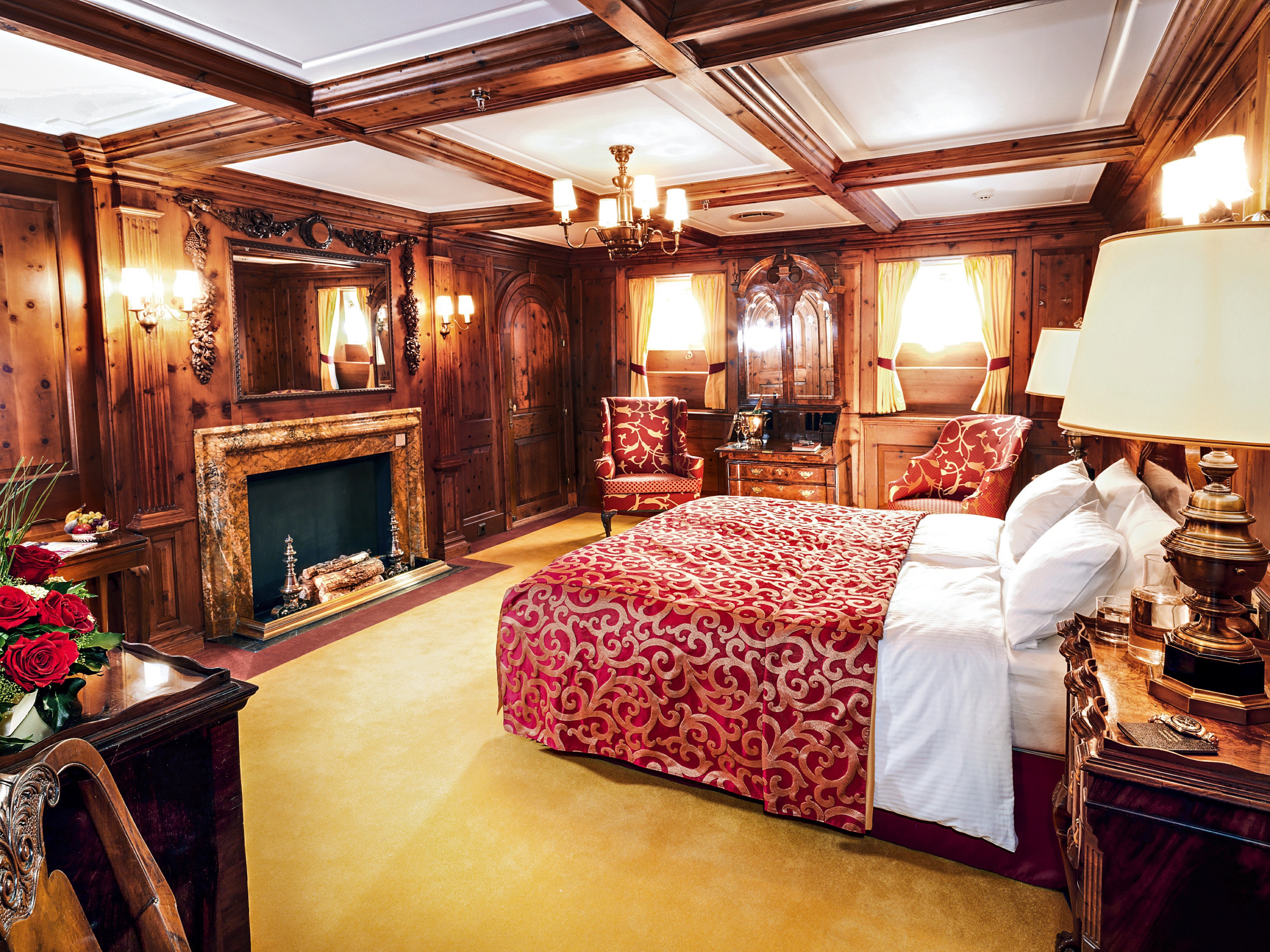
Luxury Owner's Cabin (Cat. A)
Like all the original accommodations, Marjorie Merriweather Post furnished the owner’s suites herself. Whenever she traveled aboard the SEA CLOUD, these posh, private quarters were her home, so she outfitted them in opulence. Today, her personal owners’ suite maintains her exquisite touch with white Carrara marble in the fireplace and bathroom, gold-plated swan fixtures, Louis Philippe chairs, an elaborate floor-to-ceiling dressing mirror and ornate golden-trimmed ceilings. The high-end design and furnishings reflect the successful entrepreneur’s penchant for luxuriating on this private yacht in ultimate comfort.
Cabin 1
- approx. 410 sq. ft. / 38 m2
- Marble bathroom approx. 97 sq. ft. / 9 m2 with shower and bathtub
- dressing table and golden fittings
- California king bed, 71 x 79 in. / 180 x 200 cm
- walk-in closet
- marble fireplace (electric)
- safe
Cabin 2
- approx. 366 sq. ft. / 34 m²
- marble bathroom approx. 97 sq. ft. / 9 m² with shower and bathtub
- California king bed, 71 x 79 in. / 180 cm x 200 cm
- walk-in closet
- marble fireplace (electric)
- safe
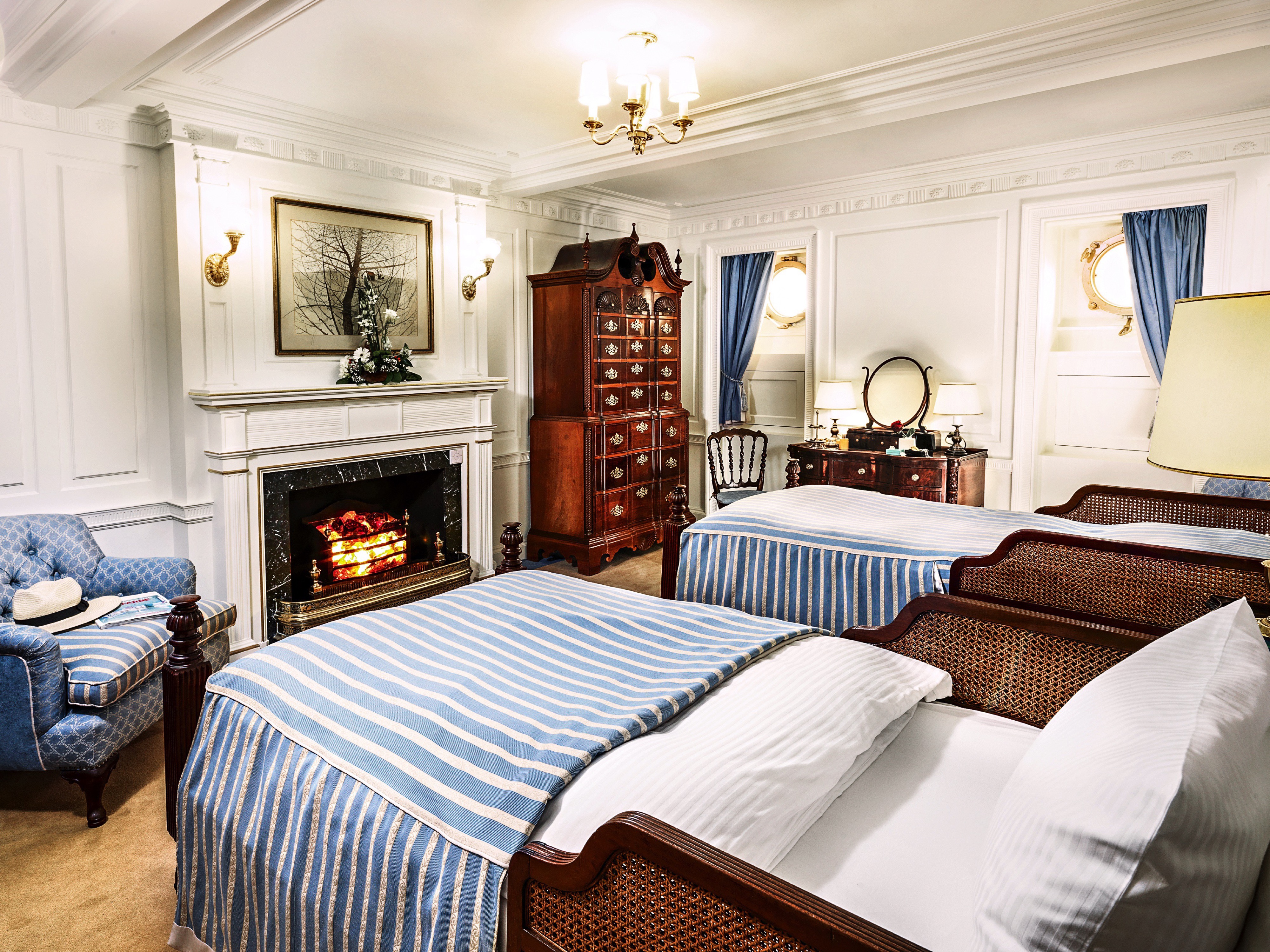
Deluxe Suite (Cat. B)
Suite 3 – The hospitality Marjorie cultivated still characterises a stay on board the SEA CLOUD today. The original colonial style of this deluxe suite continues to welcome guests with the posh comforts and ambiance of a private yacht. Renowned nobility, celebrities and industry titans have all called these deluxe suites home on legendary sailings.
- approx. 258 sq. ft. / 24 m²
- marble bathroom approx. 43 sq. ft. / 4 m² with shower, bathtub, and golden fixtures
- two twin beds, 36 in. x 79 in. / 90 cm x 200 cm each
- walk-in closet
- marble fireplace (electric)
- safe
Suite 4 – Throughout the commissioned construction of the SEA CLOUD in Kiel, Germany, and later when Marjorie was already living on board, she collected precious antiques from all over the world. This deluxe suite is one of the many examples of how skilfully she integrated the valuable pieces into the interior, and thus, into the overall appearance and ambiance of her private luxury yacht.
- approx. 237 sq. ft. / 22 m²
- marble bathroom approx. 54 sq. ft. / 5 m² with shower, bathtub, and golden fixtures
- queen bed, 63 in. x 79 in. / 160 cm x 200 cm each
- walk-in closet
- marble fireplace (electric)
- safe
Suite 5 – Marjorie frequently mentioned her goal of making family, friends and notable guests feel at home every minute on board the SEA CLOUD. Accordingly, she designed spaces like this deluxe suite to feel like the ultimate in comfort, five-star accommodations. Antique mahogany chests of drawers, marble in the bathroom and by the fireplace and unique pieces create cozy elegance.
- approx. 215 sq. ft. / 20 m²
- marble bathroom approx. 58 sq. ft. / 5,4 m² with shower, bathtub, and golden fixtures
- two twin beds arranged as a double, 36 in. x 79 in. / 90 cm x 200 cm each
- walk-in closet
- marble fireplace (electric)
- safe
Suite 6 – Exclusive getaways on the SEA CLOUD are also journeys through time. The original design and decor of the deluxe suites feel like a portal to a bygone era of glamor. In the spirit of private yachting, this antique mahogany furniture was selected so as not to overwhelm the space, and the fabric palettes complement the light ambiance of elevated comfort.
- approx. 194 sq. ft. / 18 m²
- marble bathroom approx. 43 sq. ft. / 4 m² with shower, bathtub, and golden fixtures
- California king bed, 71 x 79 in. / 180 cm x 200 cm
- walk-in closet
- marble fireplace (electric)
- safe
Suite 7 – As the SEA CLOUD’s original owner, Marjorie designed the interiors of her luxury sailing yacht with such attention to detail because she wanted to offer her daughter, Dina Merrill, a wonderful and safe home on board. This is especially noticeable in this deluxe suite where Dina spent a large part of her childhood. The warm maple finishings stand out with dramatic mahogany inlays. The unusual floor plan, including an angled fireplace makes the space feel even larger.
- approx. 258 sq. ft. / 24 m²
- marble bathroom approx. 75 sq. ft. / 7 m² with shower, bathtub and golden fixtures
- two twin beds, 36 in. x 79 in. / 90 cm x 200 cm each
- walk-in closet
- marble fireplace (electric)
- safe
Suite 8 – The main deck, where the original suites are located, is the heart and soul of the SEA CLOUD. This deluxe suite envelopes guests in its spirit of an exclusive private yacht. It is on display in the all the details, from fixtures to furnishings to finishings, complemented with a regal red and coral palette. Built-in cabinetry creates extra space.
- approx. 268 sq. ft. / 25 m²
- marble bathroom approx. 65 sq. ft. / 6 m² with shower, bathtub, and golden fixtures
- California king bed (2 mattresses), 71 x 79 in. / 180 cm x 200 cm
- additional fold-out bed
- walk-in closet
- marble fireplace (electric)
- safe
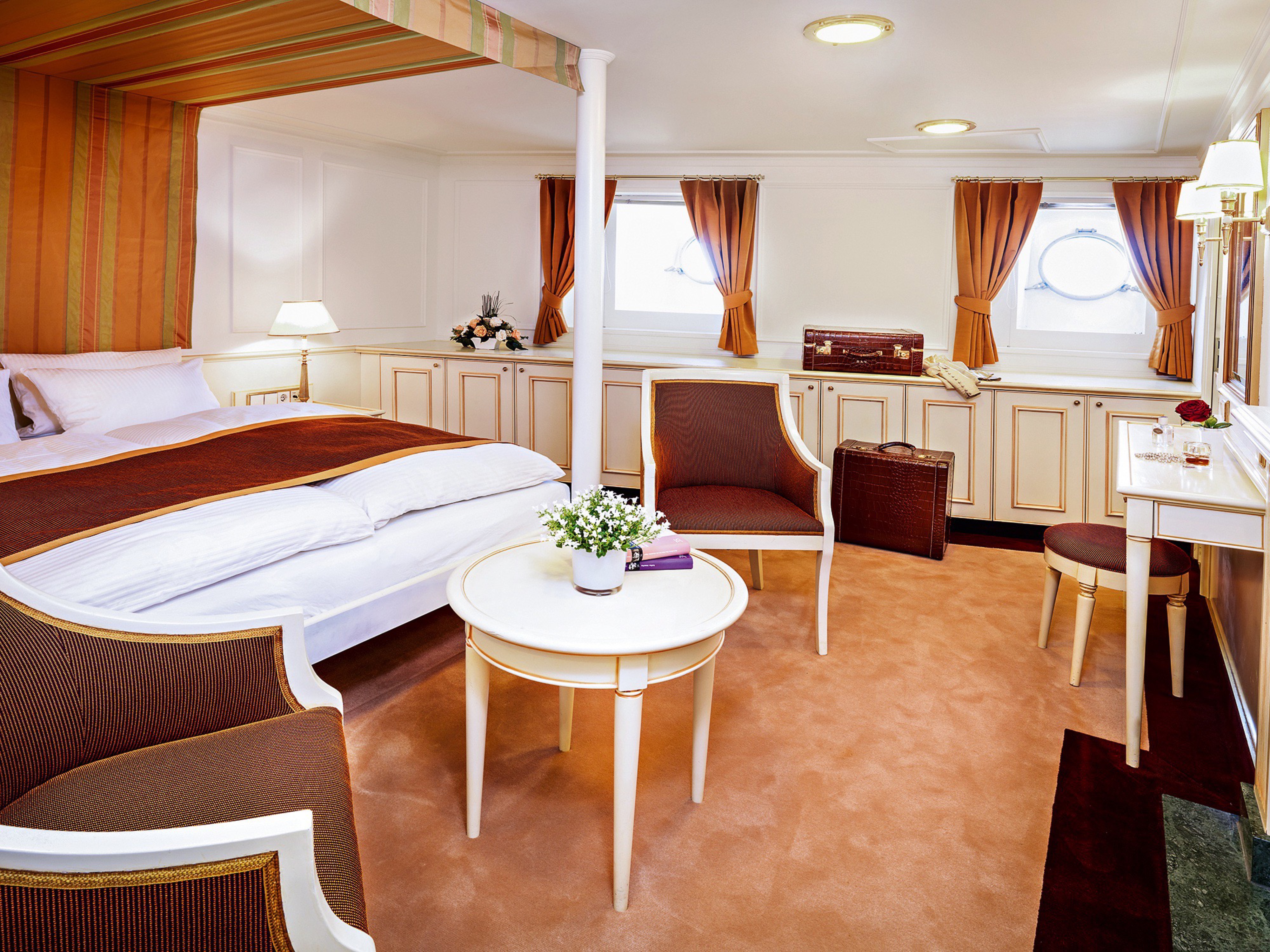
Deluxe Suite (Cat. C)
Deluxe Suites 9 and 10 are also part of the original accommodations on the main deck. Once used as single cabins for the former shipowners’ staff and their guests, they were redesigned into large luxury lodgings during renovation of the SEA CLOUD.
- approx. 215 sq. ft. / 20 m²
- marble bathroom approx. 35 sq. ft. / 3,6 m² with shower, bathtub, and golden fixtures
- queen bed, 63 in. x 79 in. / 160 cm x 200 cm
- walk-in closet
- generous storage space
- safe
The design of Deluxe Suites 9 and 10 is based on historical models with a modern aesthetic in warm fabrics and light wood tones. Both suites are located at the end of the original hallway and connect to the promenade deck by a separate staircase.
- approx. 198 sq. ft. / 18,5 m²
- marble bathroom approx. 39 sq. ft. / 3,3 m² with shower and golden fixtures
- queen bed, 63 in. x 79 in. / 160 cm x 200 cm
- walk-in closet
- generous storage space
- safe
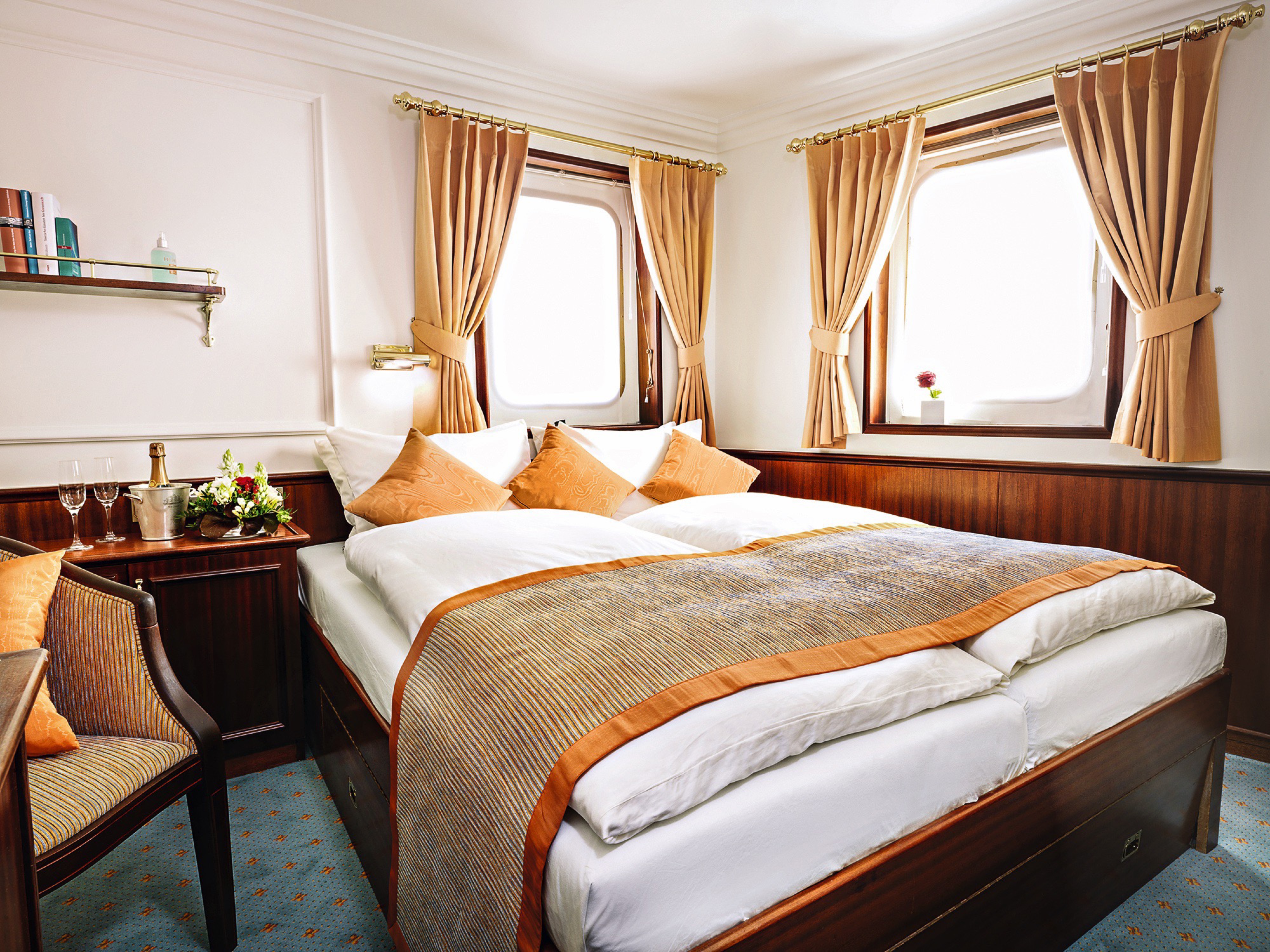
Cat. 1 Staterooms
Like all staterooms on the captain’s and lido deck, these two were built as recently as the late 1970s and offer all the comforts of private yacht accommodations. Panoramic windows cornering the head of the bed create a bright, airy vibe with views to match.
- approx. 140 sq. ft. / 13 m²
- marble bathroom with shower and golden fixtures
- queen bed (2 separate mattresses), 63 in. x 79 in. / 160 cm x 200 cm
- spacious closet
- safe
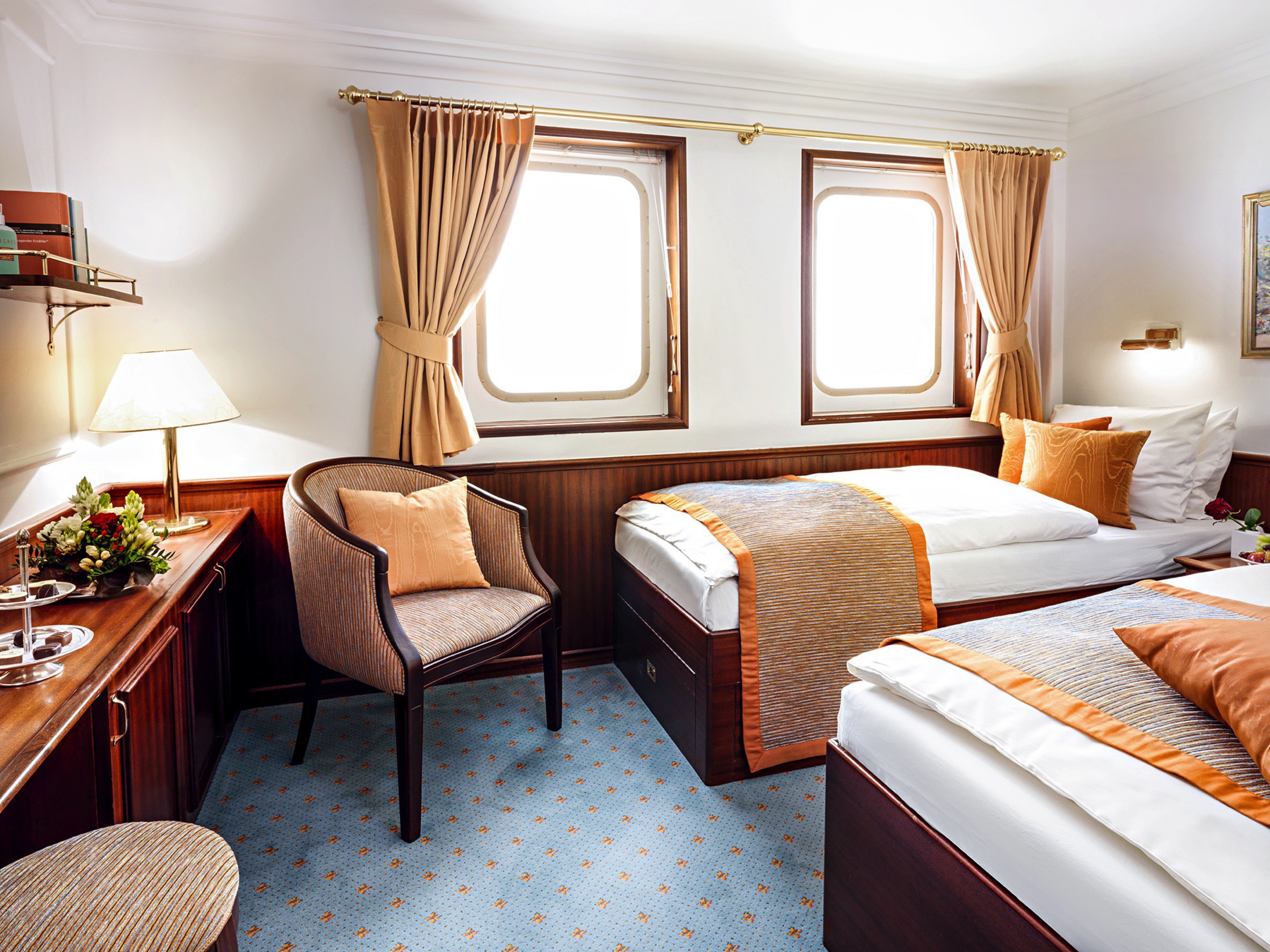
Cat. 2 Staterooms
Even though the staterooms on the captain’s and lido deck were harmoniously integrated into the SEA CLOUD after her initial construction, they still follow the design standards set on the original. Their tasteful interiors are a contemporary interpretation of Marjorie’s aesthetic from the 1930s. The elevated comfort of the spaces is complemented by spectacular sea views from double windows.
- approx. 145 sq. ft. / 13,5 m²
- marble bathroom with shower and golden fixtures
- two twin beds, 36 in. x 79 in. / 80 cm x 200 cm (convert to queen upon request)
- spacious closet
- safe
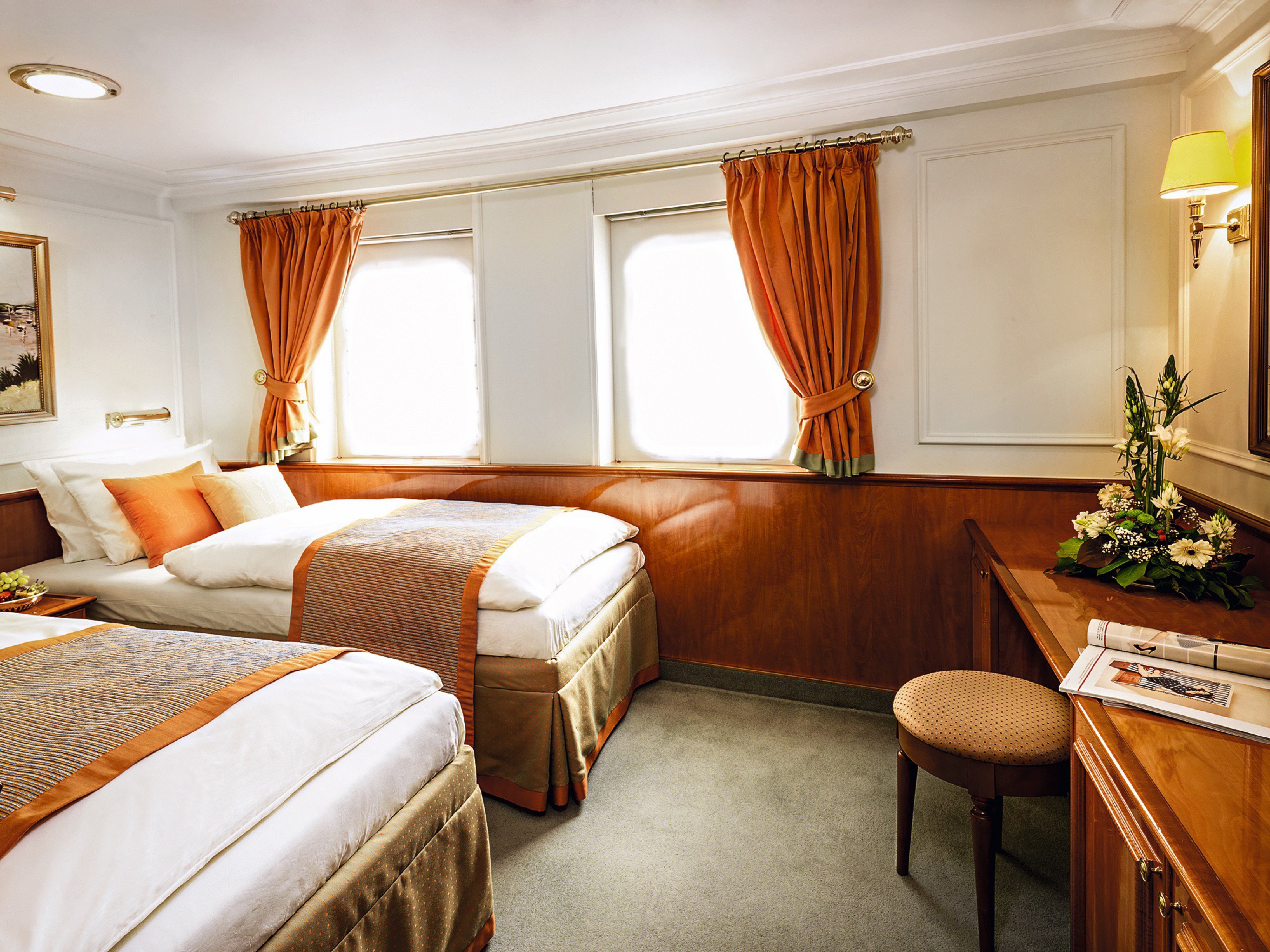
Cat. 3 Staterooms
These plush staterooms have a special maritime charm due to their location between the stations for hoisting and lowering the sails. The deckhouse, which was added during the renovation of the SEA CLOUD, is an oasis of peace, and due to its location on the promenade deck, the staterooms are also only steps away from the restaurant and lounge.
- approx. 135 sq. ft. / 12,5 m²
- marble bathroom with shower and golden fixtures
- two twin beds, 36 in. x 79 in. / 80 cm x 200 cm
- closet
- two windows with sea views
- safe
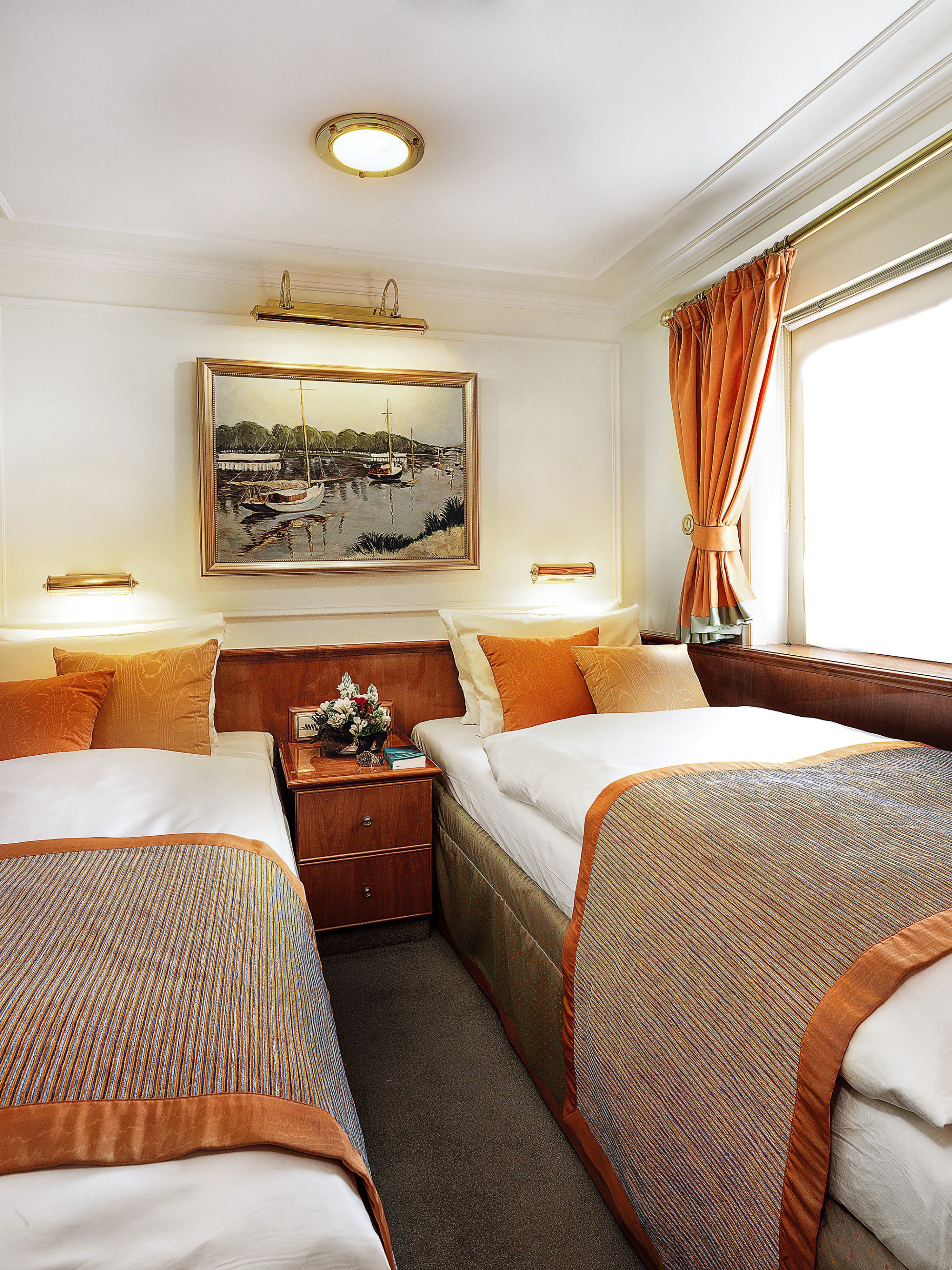
Cat. 4 Stateroom
In addition to the luxurious comfort that defines the SEA CLOUD, both staterooms offer a special feature: direct access to the most charming place on the tall ship, the Blue Lagoon. The semi-circular, blue-cushioned space is the traditional onboard area for relaxing under the daytime sun or dreamy night views of starry skies twinkling off the ocean.
- approx. 113 sq. ft. / 10,5 m²
- marble bathroom with shower and golden fixtures
- two twin beds, 36 in. x 79 in. / 80 cm x 200 cm
- closet
- window with sea view
- safe
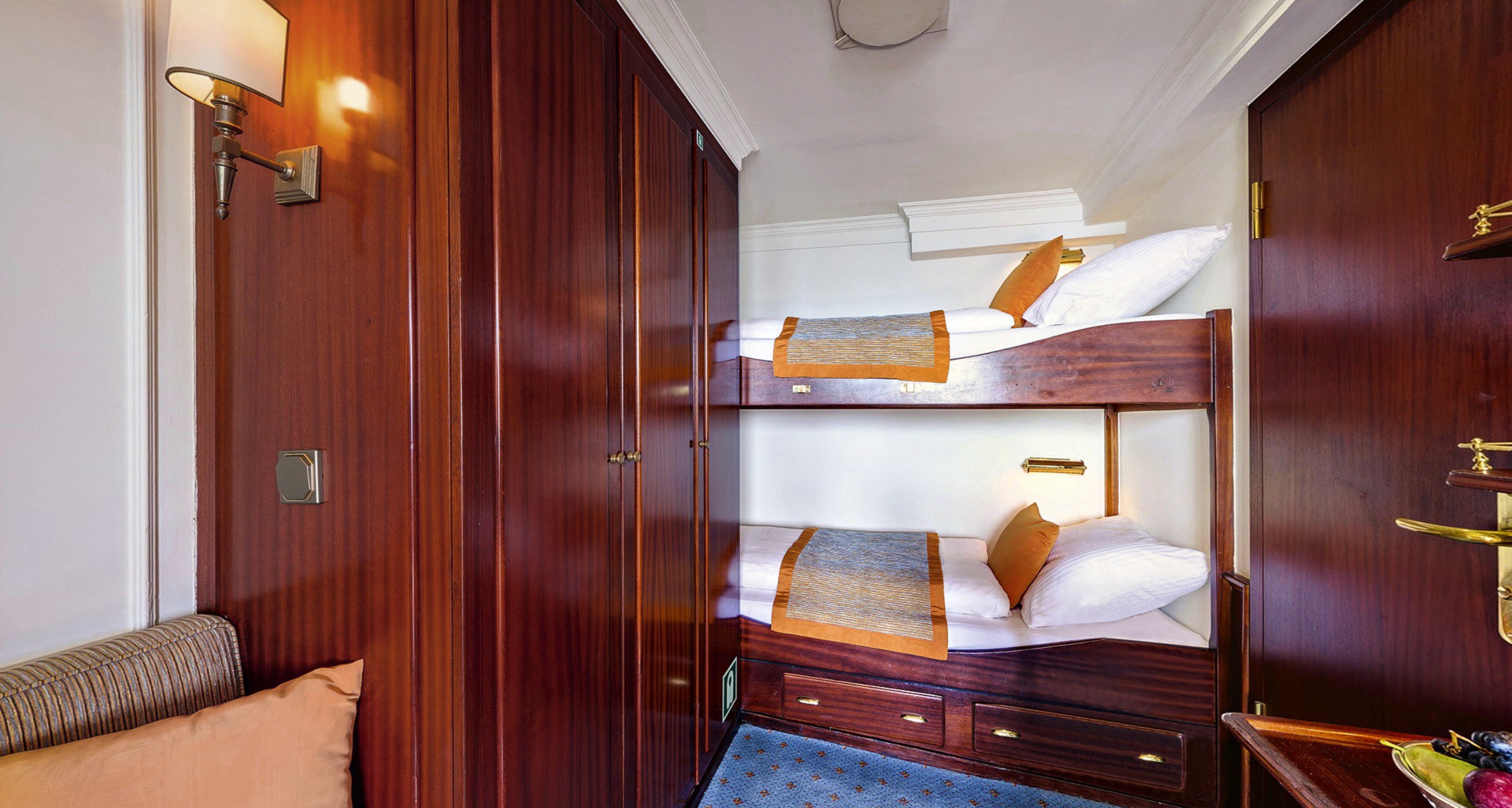
Cat. 5 Staterooms
These special staterooms were made for sailing enthusiasts. In Marjorie’s time, these were accommodations for SEA CLOUD officers, thus, the vibe is authentically nautical. The best part, which is exclusive to these staterooms, is direct access to the promenade deck, directly below the bridge. Open the door to breathe in the salty sea air and experience the charming maritime ambience.
- approx. 102 sq. ft. / 9,5 m²
- marble bathroom with shower and golden fixtures
- upper and lower beds, 32 in. x 79 in. / 80 cm x 200 cm
- closet
- porthole and door to promenade deck
- safe

Guarantee Cabins
Space is limited. Allocations are at SEA CLOUD CRUISES’ discretion starting in Category 5. You will receive your exact stateroom number when arriving on board.
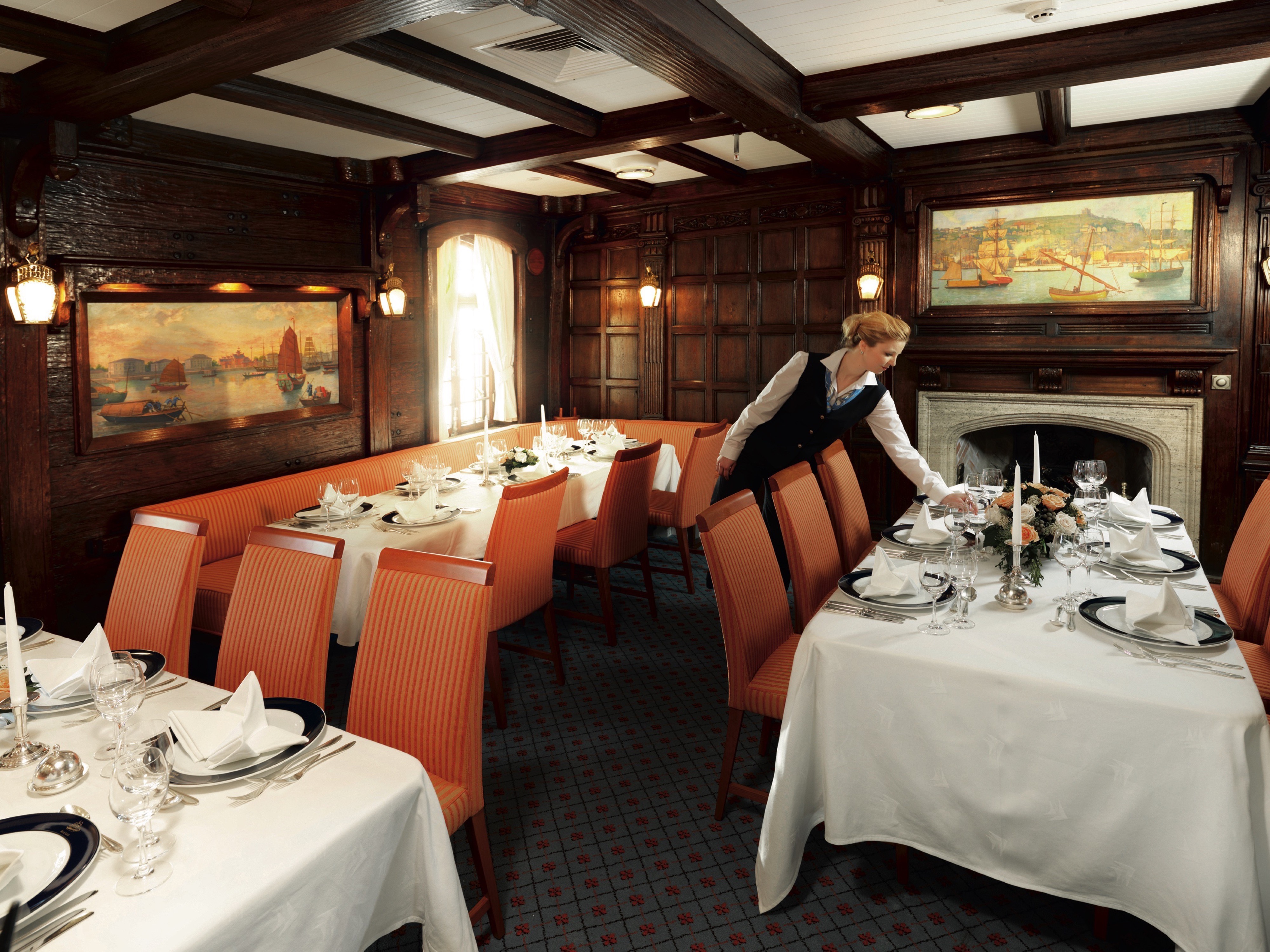
Dining On Board
Meals are served on our ships in one seating. Service times can be found in the daily program on board. Please kindly note that reservations are not possible.
A small breakfast with pastries and fruits is offered to early and late risers onboard the SEA CLOUDs. On the SEA CLOUD, it’s located on the Panorama Deck (early risers) or the Lido Deck (late risers). The main breakfast buffet is provided in the restaurant. Lunch is served as a buffet on the lido deck or in the restaurant. In the afternoon, coffee and tea are served, accompanied by some sweet treats and sandwiches. Dinner is a four-course menu with entrees to choose including a vegetarian option. Our executive chef will prepare an exclusive five-course meal for the gala dinner. A late-night snack nicely rounds up the evening’s culinary delights.
We maintain the tradition that at the beginning and towards the end of a voyage, the captain invites you to a Captain’s Cocktail, followed by a (Captain’s) Gala Dinner in the restaurant. For this occasion, we recommend elegant cocktail attire.
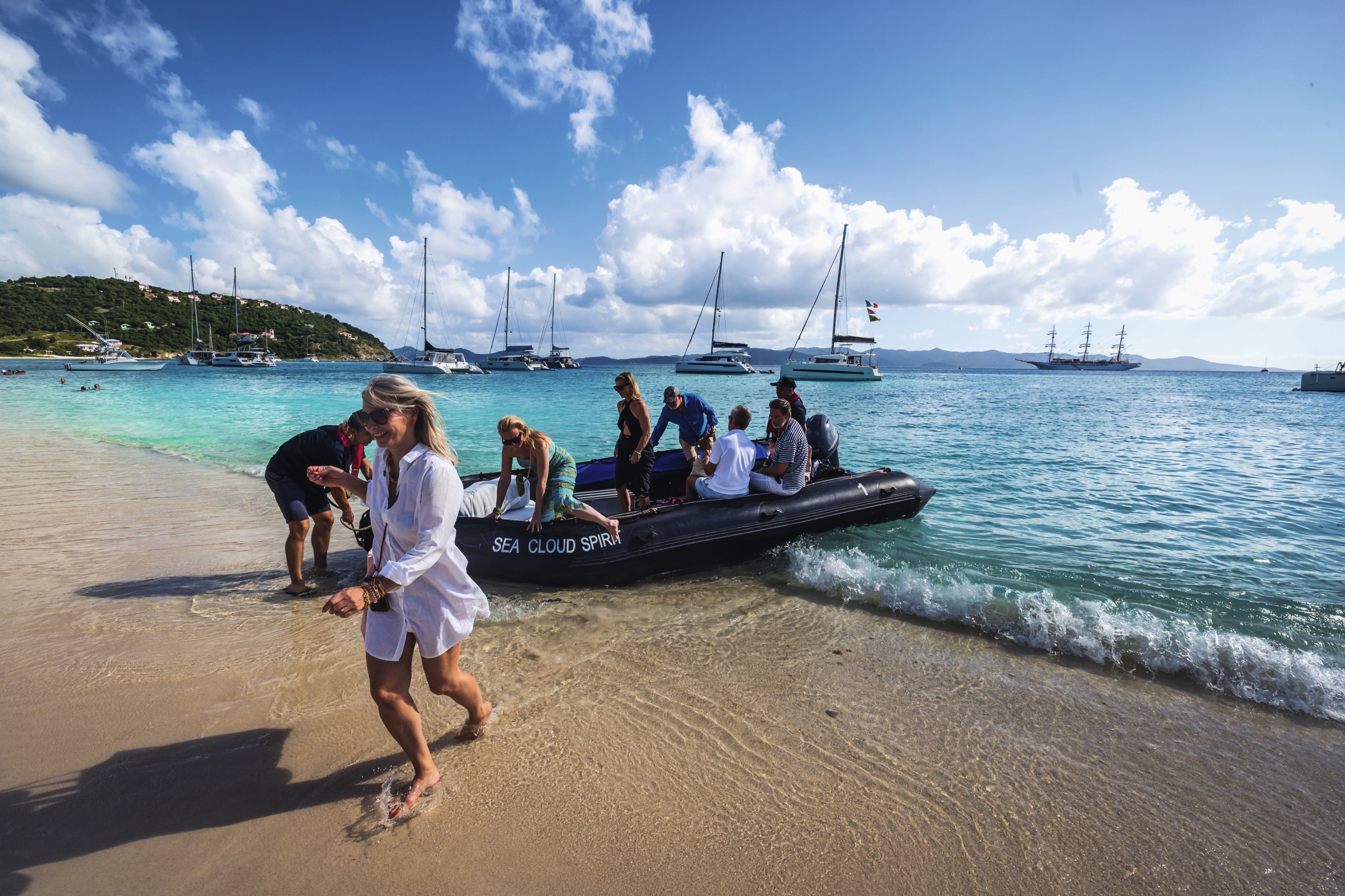
Zodiacs
Zodiacs are small motor-driven rigid-hull inflatable boats with a capacity of approximately 8 to 10 guests, primarily used for beach landings on our cruises or our photo safaris.

Watersports
Water sport activities are offered from the gangway on SEA CLOUD.
We do have snorkelling equipment in different sizes on board, stand-up paddle bards for beach landings.
All water sport activities are included and subject to weather and Captains permission.

Excursions
All our shore excursions are shown on the itinerary pages of our brochure. 4 weeks prior to departure you will receive detailed information on shore excursions with your travel documents. The shore excursion booklet also includes the order form to pre-book your excursions. On board the Cruise Director will be able to provide further details during a lecture. We do recommend pre-booking prior to embarkation to secure your spot. All excursions will be charged to your cabin account on board.
You are free to join an organised shore excursion, stay on board or make individual arrangements. You will find times for tender or to be back on board in your daily program and at the gangway.
Please remember to bring comfortable footwear, a light jacket/windbreaker, as well as sunscreen where appropriate.

Rigg Climbing
Join us for some rigg climbing
One of the most captivating experiences onboard the SEA CLOUD windjammer is watching the crew climb into the rigging to set the sails by hand. Now, you can share a piece of this adventure yourself and – if your fitness allows – climb up to the first platform!
Our SEA CLOUDs are the only cruise ships in the world that are traditionally sailed by hand. Here, nothing happens at the push of a button: setting the sails follows centuries-old rituals, bringing the magic of sailing to life in a unique way. Now, you can experience this tradition up close! High up in the rigging, carried by the wind and with sweeping views over the sea, you’ll feel the majestic power of our tall ships even more intensely. Safely guided and equipped with state-of-the-art safety systems, you can climb up to the first platform, about 14 meters above the deck – an unforgettable moment for those seeking adventure!
A brief fitness check on board ensures that you feel completely comfortable and secure before you ascend. This includes: hanging from a bar for 10 seconds, balancing on one foot for 20 seconds and climbing stairs two at a time. Our experienced deckhands, specially trained for these activities, will guide you every step of the way so you always feel safe and well taken care of.
Embark on this unique adventure now – a once-in-a-lifetime moment that will leave you with a deep sense of joy and a touch of pride. Are you ready to experience the sea in all its splendour, high above the sails?

The Lounge
The lounge is located on the Promenade Deck and is always open. This is where all lectures take place and on select sailings concerts on the Steinway grand piano (SEA CLOUD II and SEA CLOUD SPIRIT). Enjoy a selection of games or just an afternoon snack.
The Lounge Bar is open daily from 11:00 am. All drinks, alcoholic and non-alcoholic are included, premium drink are at an additional charge.
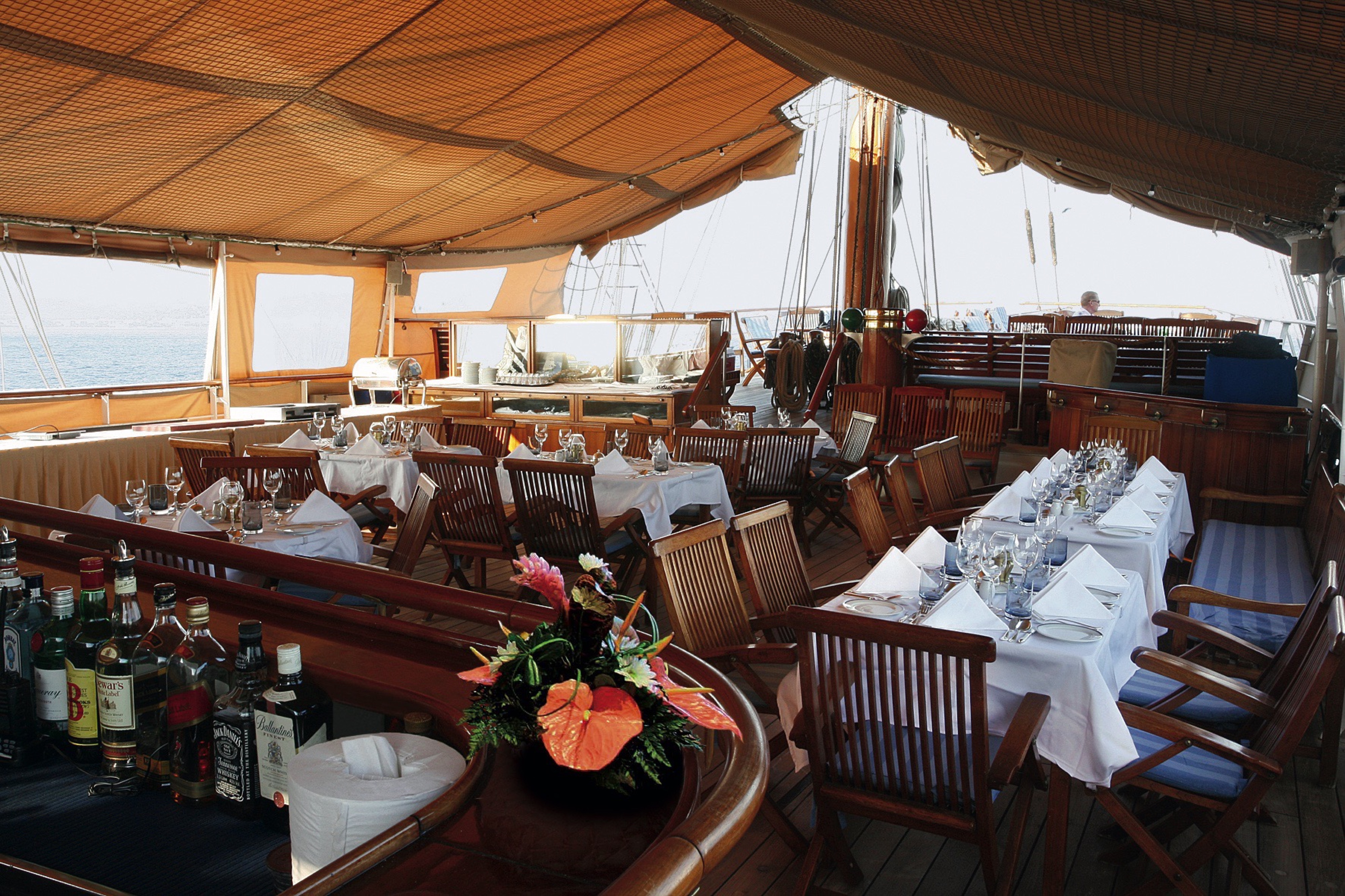
The Lido and Promenade Deck
If the weather is fine, you might like to sit on the lido deck at lunch time. The tasty snacks served at the buffet in the open air will both whet and satisfy your appetite. At certain times, our onboard pianist will provide pleasant background music to your conversations. The lido bar is a cosy place to wind down the evening. Quite befitting for any traditional sailing ship, the atmosphere can also get rather vibrant when the Crew Shanty Choir makes an appearance.
Not only is the promenade deck a quick route from one end of the ship to the other; in good weather, you will also find some very tasty refreshments there. The coffee, tea and light snacks are ideal for those who rise early, but also to provide sustenance in the afternoon between meals. Just imagine a freshly made waffle with ice cream under the white sails of a ship – that really is pure paradise!
The Lido is open daily from 11:00 am. All drinks, alcoholic and non-alcoholic are included, premium drink are at an additional charge.
Onboard SEA CLOUD, the ship’s office is located on the Promenade Deck and serves as a reception. The purser and radio operator are available from 8:00 am to 5:00 pm in the ship’s office.
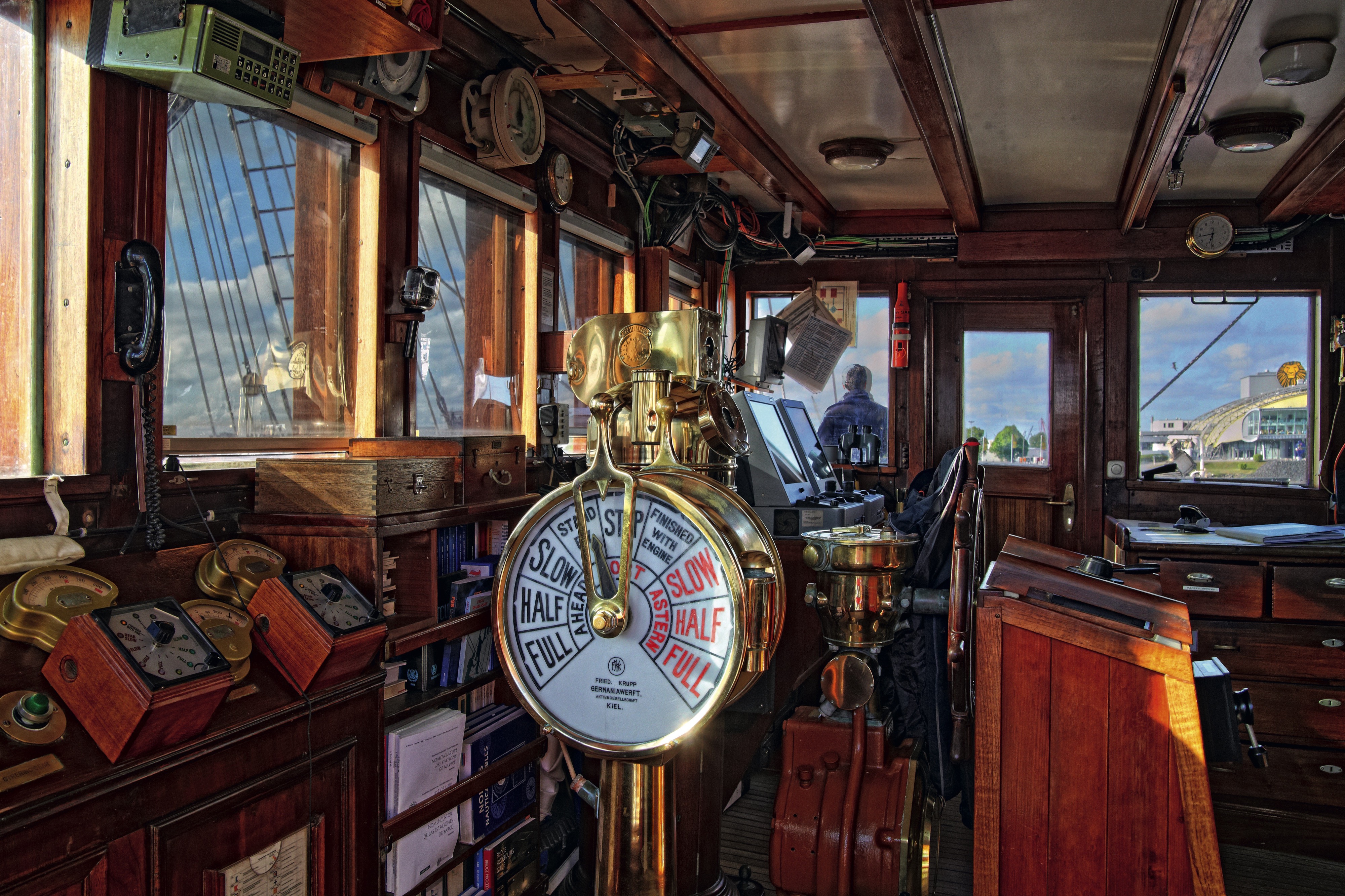
Bridge
The bridge area can be visited during the day and/or at specified times, subject to captain’s approval. The bridge is closed during manoeuvring operations and night sailing.

Boutique
The boutique on our yachts offers accessories, clothes, and gifts. The boutique’s opening times vary depending on the ship’s itinerary. You will find the exact hours in the daily program and on the displays. You can also contact the reception with questions or requests outside of opening hours.
Special Dietary Requirements
Please inform us prior to your cruise if you have any allergies, intolerances, or other special dietary restrictions. We will try to accommodate your needs as far as possible.
Dress Code
During the day, we recommend casual chic, yachting clothes. The evenings are casual elegant. Please refrain from wearing swimwear during lunch and/or shorts at dinner. For the Captain’s Dinner (once or twice depending on lengths of the cruise), we recommend elegant cocktail attire, a suit or ensemble for the gentleman and matching dress for the lady. We additionally suggest bringing non-slippery boat shoes.
Disabled Access
Our windjammers, SEA CLOUD, SEA CLOUD II and SEA CLOUD SPIRIT, are not barrier-free and, therefore, unsuitable for wheelchair users. Please contact our reservations directly for details.
There are no elevators on the SEA CLOUD and SEA CLOUD II, only staircases. SEA CLOUD SPIRIT is equipped with an elevator. You will access and depart the ship via the onboard gangway, which is not always level. Depending on weather conditions, access might be steep. The tenders or zodiacs service is done via the gangway. Please contact us prior to cruise if you have any questions regarding accessibility. If you need specific medical arrangements, please contact us in advance.
Smoking Policy
Smoking is permitted only on the lido deck outside of mealtimes. We kindly request that smokers take the other passengers into consideration. Smoking is always prohibited in covered areas on the lido deck, of the spanker deck (SEA CLOUD), on the blue lagoon (SEA CLOUD II), on the sun deck and on the verandah (SEA CLOUD SPIRIT).
Internet Access
Each of our yachts is equipped with Starlink satellite internet. All three ships offer WI-FI access in the public areas and in the staterooms. You can use your own laptop to access the Internet with an access code (WI-FI). Data volume of 10 GB is free of charge; additional data volume can be obtained from the reception desk at a charge. Continuous reception cannot be guaranteed; in certain sailing areas or due to the set course, interruptions to network coverage might be experienced. The WI-FI connection on a ship is not comparable to the usual reception on land.
On board, a laptop that is located in the lounge (SEA CLOUD) or in the library (SEA CLOUD II & SEA CLOUD SPIRIT) can be used for e-mail use on board. The SEA CLOUDs have their own on-board email addresses as follows:
SEA CLOUD: seacloud@seacloud.com
SEA CLOUD II: seacloud2@seacloud.com
SEA CLOUD SPIRIT: passenger@scs.seacloud.com
Please advise anyone you give the above email address to not send messages with attachments. Please put your name and cabin number in the subject line to ensure that the reception can forward any correspondence to you. They will hand you a printout of the e-mail.
Incoming and outgoing e-mails up to 50 KB in size can be received or send free of charge. However, files larger than 50 KB per message are automatically rejected by the system.
Due to limited network availabilities at sea, cell phones use is limited. The SEA CLOUDs are equipped with Starlink that ensures WIFI connection. Phone numbers to reach the ship can be found in your travel documents and on board.
Laundry Services
Laundry services on board are limited to washing and ironing. There is no dry cleaning available. You will find a price list for the overnight laundry and ironing service in your closet. For guests who have booked a suite in category A-C (SEA CLOUD) or category A+B (SEA CLOUD II & SEA CLOUD SPIRIT) the laundry service complimentary. For safety reasons, passengers are not permitted to iron in their cabins.
Children on Board
Children are welcome on our ships, but please keep in mind there is no daycare or special entertainment for children on board our ships.
Sustainability & Low Impact Tourism
OUR CONTRIBUTION TO ECO-FRIENDLY TRAVEL
We approach the people and their cultures with respect in all the regions we visit, travelling mindfully through the local environment. By doing this, we can bring our guests closer – in the truest sense of the word – to these places, and what makes each one special.
THE WINDJAMMER EXPERIENCE
For you and us alike, the key attraction of our trips is the chance to sail on the open seas.
We therefore take every opportunity to set sail and be propelled by the sheer power of the wind. That is why the captain will sometimes change the route if the weather requires it. On board our SEA CLOUD tall ships, you’ll experience the elements, as many of the day-to-day activities take place outside.
HAVING AS LITTLE IMPACT AS POSSIBLE
When we do have to start the engines, we utilise low-sulphur marine diesel on all three of our windjammers.
For us, this is standard practice. Even the SEA CLOUD, our very first windjammer, was equipped with this technology right from the start. Our motto: to minimise our impact on the environment yet still make a profound and positive impression on those around us.
A SUSTAINABLE APPROACH TO LIFE ON-BOARD
Avoiding plastic, reducing water usage and protecting the environment.
These are the factors that guide us in the day to day operation of our ships and our ongoing development of eco-friendly alternatives. To cite just one example, our reusable drinks bottles are not only easy on the eye, but also easy on the environment.
QUALITY, NOT QUANTITY
Our ‘small but perfectly formed’ windjammers are able to visit smaller ports, away from the busy routes frequented by large cruise liners.
With a maximum of 64 to 136 passengers, we’re always welcomed in those locations thanks to our approach of visiting local communities rather than overwhelming them. Needless to say, our itineraries also include some classic destinations, though we usually visit these only when the mega-liners have moved on.
BOOSTING THE LOCAL ECONOMY
Procuring supplies locally, working with local, smaller-scale agencies and paying fair prices.
By taking this approach, we see ourselves as a partner for our local service providers, with whom we’ve built relationships based on trust over many years. After all, we want our voyages to benefit both our guests and the communities we visit around the world.
AUTHENTIC CUISINE
Our menus are always a true reflection of the regional cuisine.
This is because our chefs enjoy buying exotic spices, local specialities and freshly caught fish from local markets to bring you – even in a culinary sense – closer to the places we visit.
A MEMBER OF THE FUTOURIS NETWORK
Heading into the future with Futouris.
Preserving the natural and cultural heritage of our world and shaping the future of tourism in a sustainable way is what Futouris stands for. Members of the network are working globally to improve people’s living conditions, preserve biodiversity and protect the environment and climate.
Medical Facilities
All three ships have a clinic and a ship’s doctor. Medical consultation hours can be found in the daily program. In case of an emergency, the doctor can be reached at any time by calling 911.
What's Included
Complimentary with your sailing:
- Welcome champagne in suite/stateroom
- Daily fresh fruit basket in suite/stateroom
- All meals including nightly 4-course menu and a 5-course gala dinner
- Fine wines from renowned winemakers and beer for lunch and dinner
- All non-alcoholic coffee and tea specialties
- All soft drinks
- Welcome and farewell cocktail
- Bottled water on excursions
- Gratuities and port fees
- Curated moments
- Beach barbecues in select destinations
- Marina platform with use of water sports equipment such as snorkel gear, stand-up paddleboards, and towable tube (weather permitting)
- Laundry service in suites

Captain's and Lido Deck
- Bridge
- Lido Bar
- Lido Deck
- Spanker Deck
- Category 1 Cabins (Double Bed)
- Category 2 Cabins (Twin Bed convertible to Double Bed)

Promenade Deck
- Purser
- Hospital
- Restaurant
- Lounge
- Category 3 Cabins (Twin beds)
- Category 4 Cabins (Twin beds)
- Category 5 Cabins (Lower and Upper bed)

Main Deck
- Category A Suites (Owner’s Suite)
- Category B Suites (Deluxe Suite)
-
Category C Suites (Deluxe Suite)

